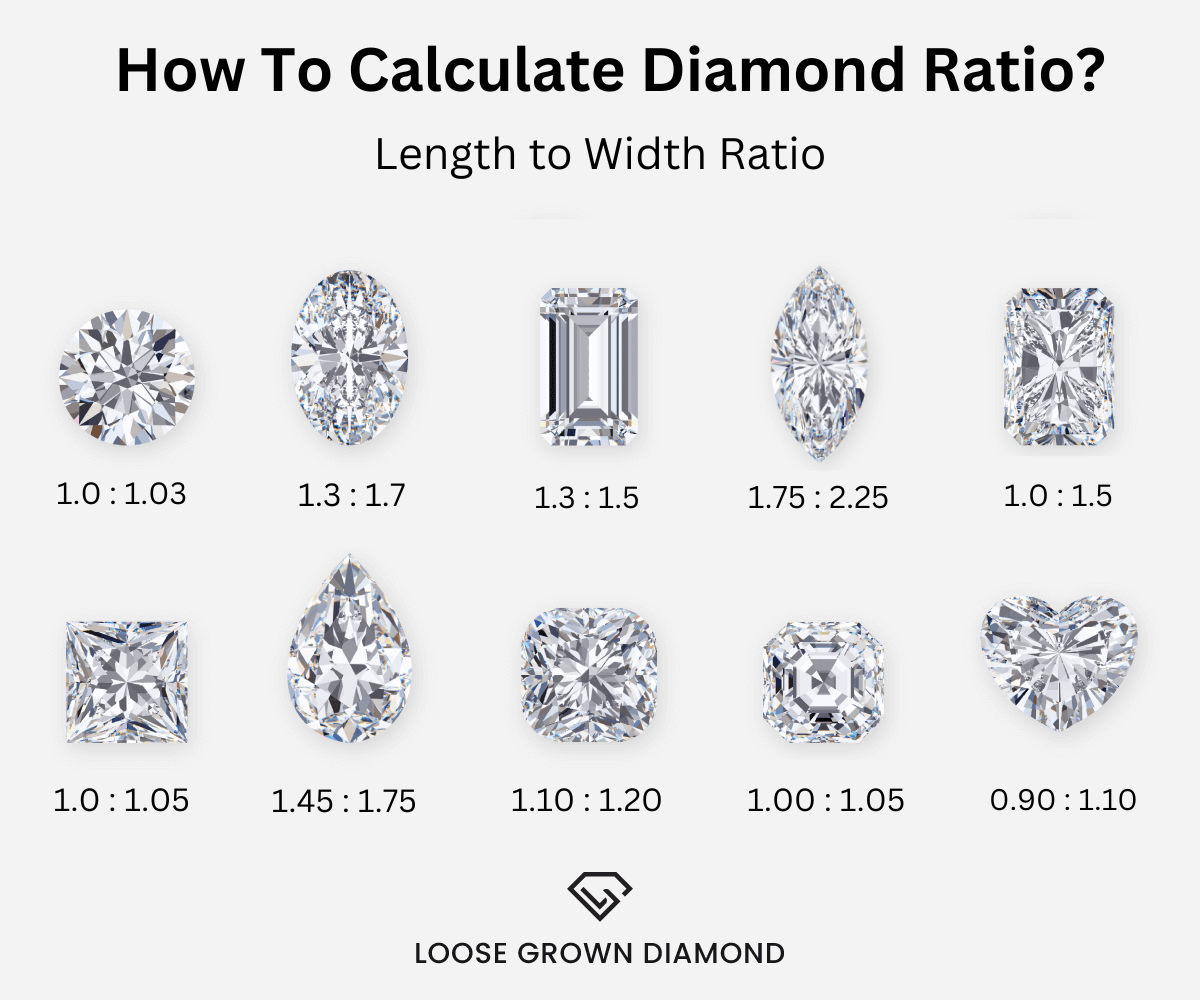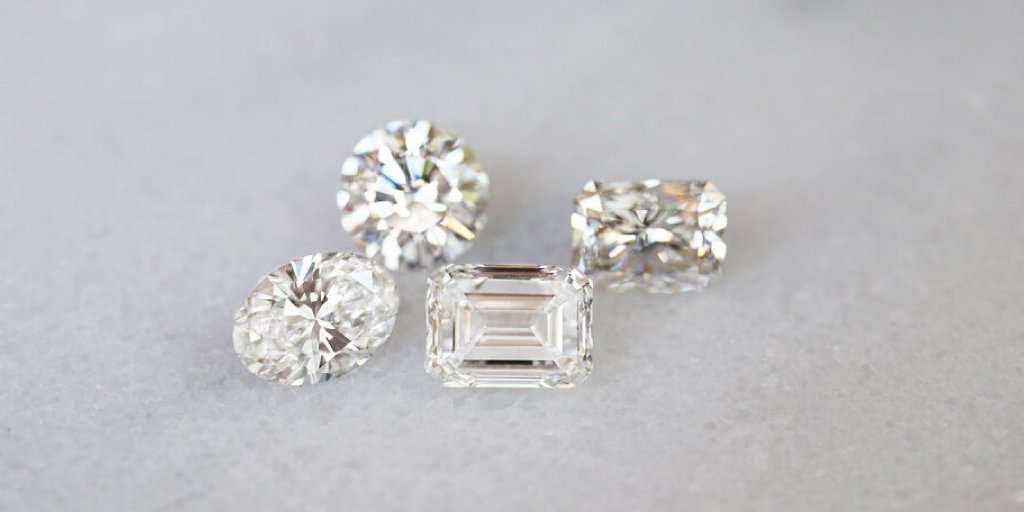A Guide to Diamond Measurement and Calculating Diamond Ratios
In the realm of exquisite gemstones, diamonds stand unrivaled, captivating us with their unparalleled elegance. However, unlocking the secrets behind their brilliance requires a deep understanding of diamond measurement and the art of calculating diamond ratios.
We at Loose Grown Diamond are going to teach you how to calculate diamond ratios in the best way possible. In this article, we embark on an enlightening journey to explore the complexity of diamond measurement, where we will get to know the significance of the 4Cs (carat weight, color, clarity, and cut) and look into the lesser-known yet crucial aspect of lab grown diamond ratios.
By looking into the world of gemology and creative techniques employed by experts, we will train and equip you with the knowledge of lab diamond assessment. Thus, enabling you to make informed decisions when it comes to selecting the perfect diamond for you.
What is the L/W Ratio of a Diamond?
The LW ratio of a diamond refers to the length-to-width ratio of the stone. It is a numerical value that shows the certified lab diamond’s proportion and shape.
The ratio is derived by dividing the diamond’s length by its width. The LW ratio provides insights into the diamond’s overall shape and appearance. Diamonds with higher LW ratios, closer to 2.0 or greater, are considered elongated or rectangular, such as emerald or radiant cuts. On the other hand, diamonds with lower LW ratios, closer to 1.0 or less, are considered more square or round, like princess or cushion cuts.
The LW ratio is an important factor to consider when selecting a diamond, as it influences the stone’s visual appeal and how it will appear when set in jewelry. Different individuals may have preferences for certain ratios based on personal aesthetics and style preferences.
Ultimately, the L-W ratio, along with other factors like the cut quality and personal preferences, should be taken into account to find a diamond that best suits your taste and desired appearance. In any case, let’s get right into the query: how to calculate diamond ratio?
How To Calculate Diamond Ratio?
To calculate the diamond ratio, follow these steps:
Measure the Length of the Diamond: Measure the longest dimension of the diamond from one end to the other with a millimeter ruler or digital caliper. Make sure to take your measurements along the diamond’s longest axis, which is usually the diagonal across the stone’s face.
Measure the Width of the Diamond: Again, using a millimeter ruler or digital caliper, measure the width of the diamond perpendicular to the length measurement. This measurement should be taken at the diamond’s widest point.
Divide the Length by the Width: Take the length measurement and divide it by the width measurement. The diamond ratio will be obtained from this computation.
The resulting calculated diamond ratio value will provide insights into the shape of the diamond. It’s important to note that personal preferences and desired aesthetics can vary, so consider the ratio along with other factors such as cut quality to find a lab diamond shape that suits your preferences.
Shape
Carat
Cut
Color
Clarity
Price
cushion
2.03
Ideal
D
VVS1
$947 $902
View
radiant
2.06
Ideal
D
IF
$2528 $2408
View
emerald
2.09
Ideal
G
VVS2
$440 $419
View
round
2.07
Excellent
D
VS1
$1558 $1324
View
emerald
1.93
Ideal
F
VS1
$617 $463
View
emerald
2.05
Ideal
G
VS1
$635 $476
View
emerald
2.05
Ideal
H
VVS2
$701 $526
View
emerald
2.05
Ideal
H
VS2
$565 $424
View
round
2.00
Excellent
G
SI1
$733 $550
View
asscher
1.90
Ideal
E
SI1
$736 $552
View
princess
2.00
Ideal
E
SI1
$823 $617
View
oval
2.00
Ideal
F
VS1
$855 $641
View
emerald
2.03
Ideal
G
VS2
$597 $448
View
round
2.03
Excellent
F
I1
$679 $509
View
round
2.03
Ideal
I
VS1
$1069 $802
View
round
2.00
Ideal
H
I1
$956 $717
View
cushion
2.06
Ideal
H
SI1
$1032 $774
View
oval
2.00
Ideal
H
SI2
$1467 $1100
View
round
2.00
Very Good
F
SI1
$1032 $774
View
pear
2.05
Ideal
E
SI1
$931 $698
View
Pointers for Length to Width Diamond Ratio
Different diamond shapes have varying length-to-width ratios, which contribute to their unique appearances. Here are some commonly recognized diamond shapes and their typical length-to-width ratios:

Round Brilliant Cut: The most popular and classic diamond shape, the round brilliant cut, is known for its exceptional sparkle. Round diamonds typically have a length-to-width ratio close to 1.0, as they are designed to maximize light reflection and brilliance.
Princess Cut: Princess cut diamonds are square or rectangular with pointed corners. They have a length-to-width ratio of 1.0 to 1.05, giving them an almost square look.
Emerald Cut: Emerald cut diamonds are rectangular with cropped corners and step-cut facets. The emerald cut diamond ratio is between 1.3 and 1.5, resulting in an elongated shape that showcases the diamond’s clarity and unique faceting.
Oval Cut: Oval-cut diamonds are elongated with rounded edges, offering a blend of brilliance and the illusion of length. The oval diamond ratio is typically around 1.3 to 1.7, depending on personal preference.
Marquise Cut: Marquise cut diamonds have a distinctive boat-shaped appearance with pointed ends. The marquise diamond ratio generally ranges from 1.75 to 2.25, emphasizing their elongated shape.
Pear Cut: Pear cut diamonds are a combination of round and marquise shapes, featuring a tapered point and rounded end. Pear diamond ratio usually ranges from 1.45 to 1.75, resulting in a teardrop-like shape.
Radiant Cut: Radiant cut diamonds are rectangular or square with trimmed corners and brilliant-cut facets. Radiant diamond ratio is between 1.0 to 1.5, providing a balance between square and rectangular designs.
Cushion Cut: Generally, cushion cut diamonds have L/W ratios ranging from 1.00 to 1.20, with some variations. A cushion cut diamond ratio of 1.00 would indicate a perfectly square cushion cut, while higher ratios like 1.10 or 1.20 would result in a rectangular cushion cut with more elongation.
Asscher Cut: Similar to emerald cuts, asscher cut diamonds are also square or rectangular. The ideal length-to-width ratio for asscher cuts falls within the range of 1.00 to 1.05.
Heart Cut: Heart shaped diamonds have a unique shape characterized by a cleft at the top and a rounded bottom. A commonly recommended length-to-width ratio for heart diamonds is around 0.90 to 1.10.
It is crucial to note that these ratios are approximations and may vary slightly depending on personal choice and the particular proportions of a diamond. Consider your aesthetic tastes, style, and desired visual qualities when choosing a diamond shape, and choose a length-to-width ratio that appeals to you.
Understanding how to calculate diamond ratio is a personal observation, and only you can decide what’s suitable for you, but perhaps this has given you a basic framework!
Conclusion
In the fascinating world of diamonds, understanding the art of diamond measurement and calculating diamond ratios provides us with a deeper appreciation for their extraordinary beauty. Through the exploration of the 4Cs and the significance of diamond ratios, we have unveiled the key factors that contribute to a diamond’s allure and visual appeal.
With this knowledge, we can confidently navigate the diamond market, making informed choices that align with our personal preferences and desired aesthetics. Whether we seek a classic round brilliant or a modern emerald cut, the ability to assess and calculate diamond ratios empowers us to find the perfect gemstone that radiates brilliance and captures our hearts for a lifetime.
Frequently Asked Questions (FAQs)
Apart from the question ‘how to calculate diamond ratio’, here are some other questions that customers usually tend to ask regarding the same topic.
What is length-to-width ratio?
The diamond length-to-width ratio is a measurement that defines the relationship between the length and width of the stone, providing insights into its shape and overall visual appearance and is expressed as a numerical value.
How do you find the length-to-width ratio?
To determine a diamond’s length-to-width ratio, measure the longest measurement as the length and the widest dimension as the width. The length measurement is then divided by the width measurement. The resulting numerical number represents the length-to-width ratio, which offers information on the diamond’s shape.
Why is the diamond ratio important?
The diamond ratio is significant because it determines a diamond’s optical appearance and aesthetic appeal. The ratio dictates the stone’s shape and proportions, whether square, rectangular, or elongated. It is essential for achieving visual balance and ensuring that the diamond has nice dimensions and symmetry. The diamond ratio helps people pick a diamond that reflects their preferred aesthetic while maximizing the stone’s beauty.
How do I measure the length and width ratio of a diamond?
To determine a diamond’s length and width ratio, use a millimeter ruler or digital calipers to measure the longest measurement as the length and the broadest dimension as the width. Make sure to measure the length along the diamond’s longest axis and the breadth perpendicular to the length measurement. Divide the length by the width to calculate a diamond ratio.





